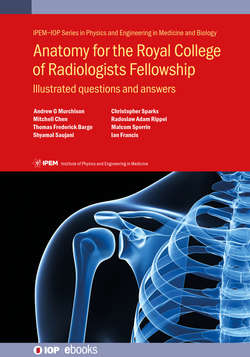Читать книгу Anatomy for the Royal College of Radiologists Fellowship - Malcolm Sperrin - Страница 11
На сайте Литреса книга снята с продажи.
Q1.3 Coronal bony reconstruction from a CT petrous bones study
Оглавление1 Name the arrowed structure.
2 Name the arrowed structure.
3 Name the arrowed structure.
4 Name the arrowed structure.
5 Name the arrowed structure.
Answers
1 Left cochlea.
2 Left atlantooccipital joint.
3 Odontoid process of C2 (dens).
4 Right head of malleus.
5 Right tegmen tympani.
Comments:
The inner ear and structure of the petrous part of the temporal bone are complex but could legitimately pop up in the exam.
The external auditory canal leads to the tympanic membrane—this is tethered at its superior margin to a bony promontory called the scutum (marked with a red asterisk). Within the middle ear are the ossicles—the malleus, incus and stapes. The base of the stapes attaches to the oval window of the inner ear, which comprises the shell-shaped cochlea and three semi-circular canals.
The roof of the middle ear is separated from the meninges and brain by a thin ceiling of bone called the tegmen tympani. A canal called the additus ad antrum opens from the superior middle ear into an air chamber within the petrous bone called the maxillary antrum.
Several important structures run through the petrous bone. The facial nerve enters the skull base through the internal auditory meatus. It travels through the petrous part of the temporal bone in the facial canal, which has a question-mark-shaped course, before leaving the skull at the stylomastoid foramen. The internal carotid artery also passes through the petrous temporal bone in the carotid canal.
Exam tips:
The incus and malleus form an ice-cream cone configuration—with the head of the malleus forming the ice cream, and the body of the incus forming the cone.
Unusual views of common structures are an exam favourite. If (when!) you find that you have no idea what the arrow’s pointing at, try to orientate yourself by identifying surrounding structures. For example, for question 2, you could identify the odontoid process of C2 poking up in the midline from the bottom of the image. That would make the two bony structures on either side the lateral masses of C1—which articulate superiorly with the skull at the atlanto-occiptal joints.
